Hanbok: Traditional Clothing of South Korea
Introduction to Hanbok
Hanbok is the traditional clothing of Korea, known for its vibrant colors, graceful lines, and distinctive design. It holds great historical and cultural significance, representing the rich heritage and identity of the Korean people. Hanbok has been worn for centuries and continues to be cherished as a symbol of national pride and cultural heritage.
Table of Contents
Definition of Hanbok
Hanbok refers to the traditional Korean clothing worn by both men and women. It consists of two main parts: the jeogori, a short jacket with long sleeves, and the chima or baji, a skirt or trousers. The jeogori is typically fastened with a tie or ornate strings, while the chima is gathered at the waist with a wide ribbon called otgoreum. The hanbok’s design and materials vary depending on the occasion and the wearer’s age and social status, making it an attire of both practicality and beauty.
A Glimpse into History
Historical Significance and Cultural Importance
Hanbok holds deep historical significance and is a reflection of Korea’s cultural identity. It can be traced back to the Three Kingdoms period (57 BC – 668 AD) and has evolved through the Goryeo and Joseon dynasties, incorporating elements from various regions and social classes. During the Joseon era, strict sumptuary laws were enacted to dictate the colors and designs of hanbok, indicating the wearer’s social status and rank.
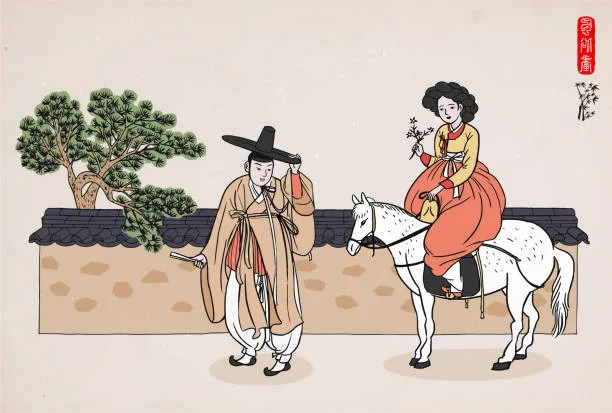
Hanbok has remained an integral part of Korean culture, playing a prominent role in various aspects of life, including weddings, holidays, and formal events. Traditional ceremonies, such as Seollal (Lunar New Year) and Chuseok (Harvest Festival), are occasions when people often don hanbok to celebrate their heritage and show respect to their ancestors.
Evolution of Hanbok
Early Origins and Influences
The roots of the Hanbok can be traced back to ancient Korea, with its origins dating back to the Three Kingdoms period (57 BC – 668 AD). During this time, various regional and ethnic influences shaped the early forms of Korean clothing. Chinese and Central Asian styles, as well as influences from neighboring cultures like the Mongols and Manchus, played a role in shaping early Hanbok.
One of the earliest forms of Hanbok was the “hanbok,” a simple robe-like garment worn by both men and women. Over time, as the Korean people interacted with other cultures through trade and diplomatic relations, Hanbok began to evolve and incorporate different elements, such as the wide sleeves and flowing lines inspired by Chinese clothing.

Key Changes and Developments Over Time:
Goryeo Dynasty (918-1392 AD): During the Goryeo period, Hanbok began to take on distinct features that would continue to define its appearance in later years. The jeogori, a shorter jacket-like top, became a prominent part of the ensemble, often adorned with beautiful patterns and intricate embroidery. The chima, a wide and voluminous skirt, started to be worn by women.
Joseon Dynasty (1392-1897 AD): The Joseon era marked significant changes in Hanbok, particularly with the implementation of sumptuary laws. These laws strictly regulated the colors, materials, and styles of Hanbok, depending on the wearer’s social status and rank. This led to a clear distinction between the clothing of the aristocracy, middle class, and commoners. During this time, the development of various accessories, such as norigae (decorative pendants) and hairpins, also became popular to complement the Hanbok attire.
Late Joseon to Colonial Period (17th – early 20th century): Towards the end of the Joseon period and into the colonial era, Hanbok underwent further changes influenced by practicality and convenience. The traditional wide skirts were replaced with narrower and more tailored designs for women, allowing for easier movement. The men’s attire also became more simplified and functional.
Modern Era (20th century): With the influence of Western fashion during the 20th century, Hanbok faced a decline in daily wear, especially among the younger generation. Western-style clothing became more popular for everyday use, while Hanbok was mainly reserved for formal occasions and traditional ceremonies.
Contemporary Revival: In recent decades, there has been a resurgence of interest in Hanbok, thanks to efforts by designers, cultural organizations, and the Korean government. Hanbok has been reimagined to suit modern tastes while preserving its traditional elements. Today, you can find a fusion of traditional and contemporary Hanbok styles, making it more accessible and appealing to a broader audience.
Components of Hanbok
Hanbok, the traditional Korean attire, consists of several distinct components that come together to create a unique and elegant outfit. Each element carries its own historical and cultural significance, contributing to the overall beauty and symbolism of Hanbok. Here are the main components:
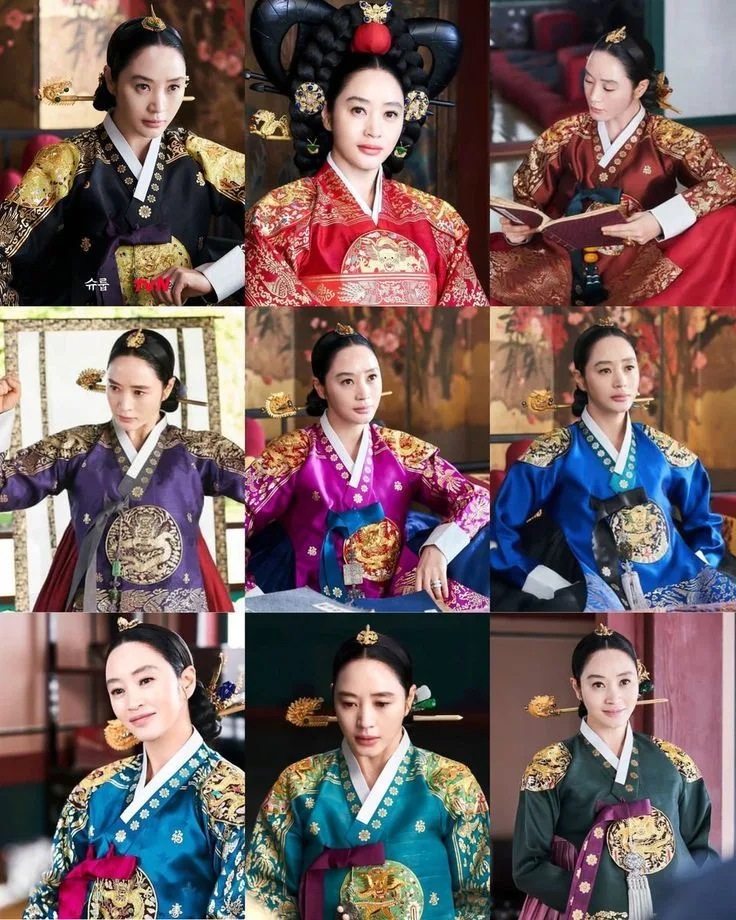
- Jeogori (Upper garment): The jeogori is the upper garment of the Hanbok and is typically a short jacket with long sleeves. It is worn by both men and women. The jeogori’s design may vary depending on the wearer’s gender, age, and social status. It features a unique wrapping style, fastened with ties or ornate strings called Gil. The jeogori is usually richly decorated with intricate embroidery, vibrant colors, and various patterns.
- Chima (Skirt): The Chima is a wide and voluminous skirt worn by women as part of their Hanbok ensemble. It is typically pleated and gathered at the waist with a wide ribbon known as otgoreum. The chima comes in various lengths, and its design may differ based on the occasion and the wearer’s age. The skirt is often made from high-quality silk, which adds to its graceful and flowing appearance.
- Baji (Pants): The baji refers to the pants worn by men in traditional Hanbok attire. They are wide and loose-fitting trousers, providing comfort and ease of movement. The baji are often made from the same fabric as the jeogori and are usually secured with a belt or string called joritdae.
- Po (Outer robe): The po is an optional outer robe that can be worn over the jeogori and chima. It is typically used during colder weather or on formal occasions. The po is an overcoat-like garment with loose sleeves and a generous fit, allowing it to be easily worn over the other layers of Hanbok.
Accessories
Norigae: Norigae is a decorative ornament that hangs from the ribbon of the jeogori. It usually consists of colorful tassels, beads, and various trinkets. Norigae serves both an aesthetic and symbolic purpose, as it is believed to bring good luck and protection to the wearer.
Gulle: The gulle is a traditional headpiece worn by women, often made of silk and adorned with decorative elements such as flowers, pearls, or jade. It complements the overall Hanbok outfit and adds a touch of elegance to the wearer’s appearance.

Wonsam (formal outer robe) and Durumagi (overcoat): These are additional outer garments that can be worn over Hanbok for special occasions or during cold weather. The wonsam is a ceremonial overcoat, usually made from silk and reserved for formal events, while the durumagi is a more casual and practical outer robe.
Each component of the Hanbok contributes to its unique charm and cultural significance, making it an enduring symbol of Korean heritage and identity. The careful craftsmanship and attention to detail in each piece showcase the deep appreciation Koreans have for their traditional clothing.
Regional Variations in Hanbok
South Korea’s diverse geography and climate have influenced the development of regional variations in Hanbok. Each region has its distinctive style and characteristics, reflecting the local culture and traditions. Some notable regional variations include:
Gyeonggi-do and Seoul: The Hanbok style in the central region, including Gyeonggi-do and Seoul, is known for its elegant and refined appearance. The colors are often subdued, and the designs are more tailored, making it suitable for formal occasions and ceremonies.
Jeolla-do: In the southwestern region of Jeolla-do, Hanbok designs are characterized by their bright and vivid colors, reflecting the region’s lively and vibrant culture. The skirts may be fuller, and the jeogori sleeves may be shorter and more voluminous.
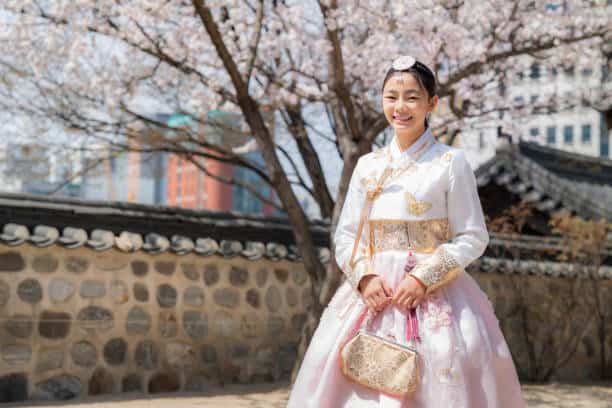
Gangwon-do: Hanbok in the northeastern region of Gangwon-do is adapted to the colder climate, with thicker and warmer fabrics. The color palette often includes earthy tones and darker shades.
Gyeongsang-do: The southeastern region of Gyeongsang-do embraces a more conservative and reserved Hanbok style, with subtle colors and simple patterns. The garments are often more practical and functional, suitable for daily wear.
Jeju-do: On the island of Jeju-do, Hanbok features unique elements inspired by the local culture. Women’s skirts may have asymmetrical hems, and the colors and patterns may be influenced by the island’s natural beauty and folklore.
Colors and Symbols in Hanbok
Symbolism and Cultural Meaning of Colors: Colors in Hanbok hold deep symbolic meaning. Red symbolizes passion, joy, and vitality, and it is often worn on special occasions and weddings. Blue represents positive energy and fidelity. Yellow and gold are associated with wealth, while green signifies fertility and growth. White represents purity and is commonly worn during funerals.

Embroidery and Patterns with Cultural Significance: Hanbok often features intricate embroidery and patterns, each with its cultural significance. Geometric patterns, such as the “saekdong” (multicolored stripes), are common and represent harmony and balance. Floral motifs symbolize prosperity and beauty, and mythical creatures like dragons and phoenixes convey auspicious meanings.
Read Discover The Best Korean Temple For A Memorable Stay
Hanbok for Different Occasions
- Ceremonial Hanbok for Weddings and Celebrations: For weddings and significant celebrations, people often wear elaborate and ornate Hanbok. Brides may wear “hwalot,” a ceremonial wedding Hanbok adorned with intricate embroidery, while grooms opt for “gwanbok,” a formal attire featuring long overcoats.
- Daily Hanbok for Casual Wear: In modern times, traditional Hanbok is mainly reserved for special events and traditional ceremonies. However, there is a growing trend of incorporating Hanbok elements into contemporary casual wear, creating comfortable and stylish daily Hanbok for more regular use.
Hanbok in Modern Fashion
- Contemporary Adaptations and Influences: Modern designers have embraced Hanbok elements and integrated them into contemporary fashion. Hanbok-inspired clothing, such as modified jeogori, chima skirts, and baji pants, have become popular choices among fashion-forward individuals.
- The Resurgence of Hanbok in Popular Culture: Hanbok’s resurgence in popular culture can be seen in Korean dramas, movies, and music videos, where actors and performers often don exquisite Hanbok for historical and cultural authenticity. This exposure has contributed to the renewed interest in Hanbok both domestically and internationally.
The Art of Hanbok Making:
Hanbok making is an intricate and time-honored craft that requires skilled artisans and a deep understanding of traditional techniques. The process involves meticulous attention to detail, from selecting the finest materials to creating beautiful designs and incorporating cultural symbolism. Here are some aspects of the art of Hanbok making:
Traditional Craftsmanship and Techniques: a. Fabric Selection: The choice of fabric is crucial in Hanbok making. High-quality materials like silk, ramie, and cotton are commonly used. Each type of fabric has its unique characteristics, contributing to the overall look and feel of the Hanbok.
b. Hand Sewing: Traditional Hanbok is often hand-sewn, showcasing the artisan’s precision and expertise. Hand-sewing allows for better control over the delicate fabrics and ensures a seamless finish.
c. Gijeogori (Pattern Making): Gijeogori refers to the process of creating patterns for each component of the Hanbok, such as the jeogori, chima, and baji. These patterns serve as a guide for cutting and sewing the fabric accurately.
d. Customization: Hanbok is often tailor-made to suit the individual’s body shape and measurements. The tailor takes great care to achieve the perfect fit, ensuring both comfort and elegance.
e. Embroidery: Intricate embroidery is a hallmark of Hanbok making. Artisans skillfully adorn the jeogori and chima with various motifs and patterns, adding a touch of artistry and cultural symbolism.
f. Dyeing: Traditional Hanbok may involve natural dyeing techniques, which create a more authentic and organic appearance. Natural dyes are derived from plants and minerals, imparting subtle and earthy tones to the fabric.
Master Artisans and Their Role in Preserving the Craft:
Experienced Craftsmen: Master artisans, often referred to as “jangsam,” are highly skilled and experienced in the art of Hanbok making. They have devoted years to perfecting their craft, passing down knowledge through generations.
Knowledge Transfer: The role of master artisans is crucial in preserving traditional techniques. They often take on apprentices, guiding them through the intricate process of Hanbok making. This ensures that the knowledge and expertise are handed down to future generations.
Cultural Guardians: Master artisans serve as cultural guardians, protecting the authenticity and integrity of Hanbok making. They understand the historical significance of each design and pattern and work diligently to maintain the cultural heritage of Hanbok.
Contemporary Adaptation: While preserving traditional methods, master artisans also play a role in adapting Hanbok to modern tastes. They incorporate contemporary elements into their designs, making Hanbok relevant and appealing to younger generations.
Artistic Expression: Hanbok making is not just a technical craft but an art form. Master artisans infuse their creativity and passion into every piece they create, transforming Hanbok into a wearable work of art.
Preserving the craft of Hanbok making is essential in safeguarding Korean cultural heritage. Master artisans, with their unwavering dedication and expertise, continue to breathe life into this timeless tradition, ensuring that the beauty and elegance of Hanbok endure for generations to come.
The Cultural Heritage of Hanbok
UNESCO’s Recognition of Hanbok as Intangible Cultural Heritage:
In 2011, UNESCO officially recognized the cultural significance of Hanbok by inscribing it on its list of intangible cultural heritage. This recognition affirmed Hanbok’s importance as a living cultural tradition that holds great value in preserving and promoting Korea’s cultural identity.
Efforts for Preservation and Promotion:
The recognition by UNESCO has spurred various efforts to preserve, promote, and revitalize the art of Hanbok making. Some notable initiatives include:
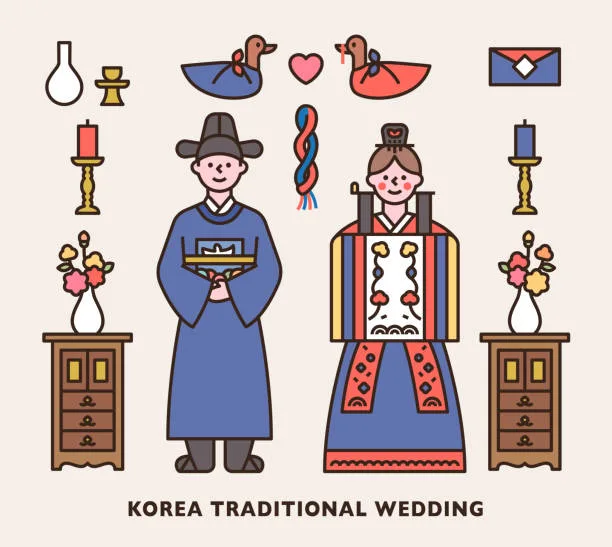
Cultural Institutions: The Korean government and cultural institutions have actively taken measures to preserve the craftsmanship of Hanbok making. They have established programs, workshops, and schools to train new generations of artisans in the traditional techniques of Hanbok making.
Cultural Festivals and Exhibitions: Numerous cultural festivals and exhibitions are organized to showcase the beauty and cultural significance of Hanbok. These events not only celebrate the traditional aspects of Hanbok but also provide a platform for contemporary adaptations and designs.
Fashion Shows and Competitions: Hanbok designers and artisans are encouraged to participate in fashion shows and competitions, both nationally and internationally. These platforms offer exposure and recognition for their creative work and innovative designs, encouraging a thriving Hanbok fashion industry.
Supporting Artisans and Craftsmanship: Various support programs and subsidies are provided to master artisans to ensure the continuity of their craft. By supporting their livelihoods, it becomes more feasible for artisans to dedicate their time and skills to Hanbok making.
Hanbok Tourism: Hanbok rental services have become popular among both locals and tourists, allowing people to experience wearing traditional Hanbok for special occasions or cultural events. This trend not only promotes Hanbok but also enhances cultural understanding and appreciation.
Media and Pop Culture: The resurgence of Hanbok in popular culture, including Korean dramas, movies, and music videos, has contributed significantly to its promotion. Celebrities wearing Hanbok in mainstream media showcase the beauty and versatility of the attire to a global audience.
International Collaboration: The South Korean government actively collaborates with other countries and organizations to share the knowledge and techniques of Hanbok making. These collaborations foster cultural exchanges and contribute to the international recognition and appreciation of the Hanbok as a cultural heritage.
Hanbok in Pop Culture and Media:
Hanbok has made a significant impact on pop culture and media, particularly in Korean dramas and movies. Its presence in these forms of entertainment has played a crucial role in promoting the beauty and cultural significance of Hanbok both domestically and internationally.
- Korean Dramas: Hanbok is a staple in historical Korean dramas, also known as sageuk. These dramas often depict various periods in Korean history, and Hanbok is used to represent the traditional attire of those times. The elaborate and exquisite Hanbok worn by characters in sageuk add authenticity and visual appeal to the storytelling. Iconic sageuk dramas like “Dae Jang Geum” and “Moon Embracing the Sun” have contributed to Hanbok’s resurgence in popularity.
- Movies: Hanbok is frequently featured in historical films, where it is used to recreate and represent past eras accurately. The use of Hanbok in historical movies adds to the overall ambiance and authenticity of the film’s setting. Korean filmmakers often pay meticulous attention to details, ensuring that Hanbok accurately reflects the cultural context and time period of the story.
Influence on Global Fashion Trends:
The popularity of Korean pop culture, including K-pop music and Korean dramas, has led to the global recognition and influence of Hanbok in the fashion industry. Several factors contribute to Hanbok’s impact on global fashion trends:
Red Carpet Appearances: Hanbok has been worn by Korean celebrities and K-pop stars at international events and red carpet occasions. These appearances have caught the attention of global audiences and fashion enthusiasts, sparking interest in the unique and elegant design of Hanbok.
Fusion Fashion: Designers around the world have been inspired by Hanbok’s elegant lines and distinctive features, incorporating elements of Hanbok into contemporary fashion. Modern fashion houses have introduced Hanbok-inspired designs in their collections, leading to a fusion of traditional Korean aesthetics with global trends.
Cultural Exchange: The growing interest in Korean culture and Hanbok has encouraged cultural exchange programs and fashion collaborations. Korean designers have been invited to showcase Hanbok at international fashion weeks, further exposing the beauty and creativity of traditional Korean attire to a global audience.
Hanbok Revival: Hanbok’s presence in global media and fashion has contributed to its revival among younger generations, both in Korea and abroad. As more people appreciate the cultural significance of Hanbok, there is a growing interest in wearing it for special occasions or incorporating Hanbok elements into modern outfits. .
Hanbok and Cultural Identity
Hanbok serves as a powerful symbol of cultural identity for Koreans, connecting them to their ancestral roots and instilling a sense of belonging. It represents a shared heritage and acts as a unifying force, reinforcing a collective Korean identity that transcends regional, social, and generational boundaries. By embracing hanbok, Koreans proudly celebrate their cultural legacy and express their unique identity in a globalized world.
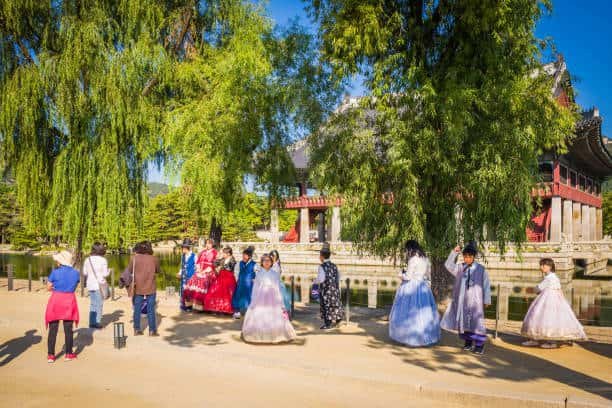
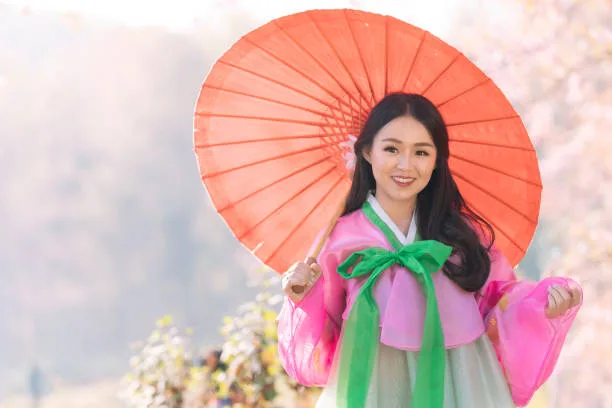
Preserving and Promoting Hanbok
Recognizing the cultural significance of hanbok, there have been ongoing efforts to preserve and promote this traditional attire. Museums showcase historical hanbok collections, while educational programs and workshops aim to pass down hanbok-making techniques and embroidery skills to younger generations. Government initiatives support hanbok-related festivals and events, fostering a sense of pride and appreciation for this cherished aspect of Korean heritage.
Conclusion
Hanbok, with its rich history, elegant design, and cultural significance, is an embodiment of South Korea’s cultural heritage. Beyond being a traditional attire, the hanbok serves as a symbol of national pride, cultural identity, and unity. As it continues to evolve and adapt to modern times, hanbok stands as a testament to the resilience and enduring beauty of traditional Korean culture. By embracing and preserving the legacy of hanbok, we honor the past, celebrate the present, and ensure its vibrant future for generations to come.
FAQ on Hanbok:
Where can I buy Hanbok?
A: Hanbok can be purchased at traditional markets, department stores, and online retailers. There are also specialized Hanbok stores that sell custom-made and high-end Hanbok.
Q: Can Hanbok be worn by anyone?
A: Yes, Hanbok can be worn by anyone regardless of age or gender. It is a traditional dress that can be enjoyed by all.
What are some popular traditional markets to buy Hanbok in South Korea?
A: Some popular traditional markets to buy Hanbok in South Korea include Namdaemun Market in Seoul, Dongdaemun Market in Seoul, and Gukje Market in Busan.
Q: What are some popular department stores to buy Hanbok in South Korea?
A: Some popular department stores to buy Hanbok in South Korea include Lotte Department Store, Hyundai Department Store, and Shinsegae Department Store.
Q: What are some specialized Hanbok shops to buy Hanbok in South Korea?
A: Some popular specialized Hanbok shops to buy Hanbok in South Korea include Goguan Studio in Seoul, Seohwa Hanbok in Seoul, and Hanboknam in Busan.
Q: Can I rent Hanbok in South Korea?
A: Yes, there are many places where you can rent Hanbok in South Korea, especially in popular tourist destinations like Seoul and Jeonju. Some popular places to rent Hanbok include Hanboknam, Oneday Hanbok, and 3355 Hanbok Rental.
Q: How much does Hanbok cost in South Korea?
A: The cost of a Hanbok can vary depending on the quality and design of the Hanbok. Generally, a high-quality Hanbok can cost anywhere from ₩100,000 to ₩1,000,000 (approximately $85 to $850 USD).
Q: Can I get a custom-made Hanbok in South Korea?
A: Yes, many specialized Hanbok shops offer custom-made Hanbok services. This can be a great option if you want a Hanbok that is tailored to your exact measurements and design preferences.
Q: What should I look for when buying Hanbok in South Korea?
A: When buying Hanbok in South Korea, it’s important to consider the quality of the fabric and the craftsmanship of the design. You should also make sure that the Hanbok fits well and is comfortable to wear.

